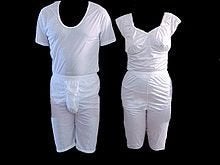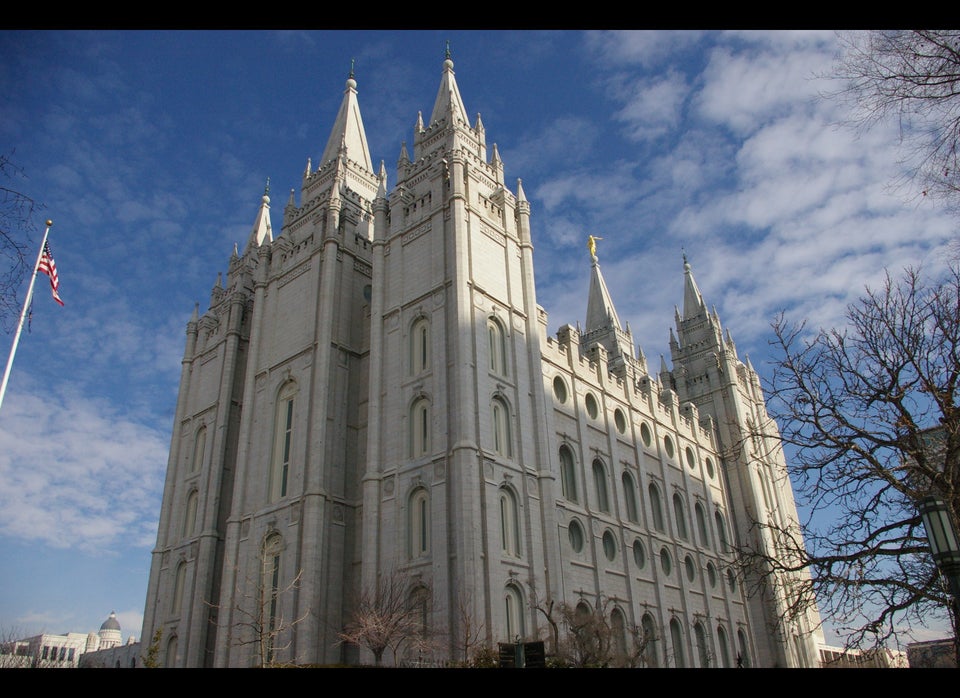
Nobody really likes to talk about their underwear, and Mormons probably have better reason than most to be reticent. They don't even call it "underwear." The term they prefer is "garments," which is taken from the King James Bible, and gives these scraps of white cloth a formal name to go along with the vaguely talismanic character they hold in the Church of Jesus Christ of Latter-day Saints. They don't look like anything special: a white T-shirt and boxer briefs, slightly longer than average, distinctive in nothing much but their color and the fact that all adult, devout Mormons, men and women, wear them.
Mormons don't use the word "underwear" to talk about their garments, and they certainly don't use the word "magic," or really believe that garments have any special powers to stop bullets or keep them from getting sick or serve as a sort of nylon-and-cotton flame retardant. There are stories of some of these things, like there are stories of the relics of Catholic saints curing epilepsy or blindness, but to most Mormons these are faith-promoting rumors, evocative but archaic folklore. The garments are a sign of devotion, a marker of faith, to be respected for the same reasons that it's considered rude to burn a Koran, but hardly mystical.
When confronted with raised eyebrows, Mormons often point to Jewish yarmulkes and tzitzit, or the communion dresses of Catholic children, or the turbans of Sikhs and collars of some Christian clergy. Sacred clothing is hardly an innovation Joseph Smith came up with, and surely mockery of a yarmulke or a Sikh turban would be horrifying and verboten in most of the tolerant Western world, even in the genealogically Protestant United States, where "religion" is supposed to be something that you believe, not something that you wear, and sacred clothing seems strange and exotic. But, of course, Mormon garments are underwear. In the determinedly public world of modern America underwear is rather less dignified - and more chuckle-inducing - than something you put on your head.
Mormons know this. Many of them find the garments as awkward as any other American might. They are manufactured by the church, and particularly for women, wearing them can be a chore: the cut might be slightly off, or the bottoms baggy, or the collar chafing. And, of course, garments mean that wearing a sleeveless dress flashes your underwear to the world, which is frustrating in Texas or Arizona. In the past forty years or so, covering the garments has become a marker of modesty for Mormons, particularly women, and sleeves are therefore essential. Combine that with the scoop neck garment shirt that many older Mormon men still wear, and you can usually pick out Mormons on vacation in Florida.
That is, in part, the point. When Bill Clinton fielded questions about his boxer shorts on MTV in 1992, there were lamentations for the American dignity the brash young candidate and his audience of chortling teenagers had flushed down the toilet. Mormons, unlike Bill Clinton, don't want to talk about their underwear. They are given their first pair of garments in young adulthood, after they participate in the endowment ceremony, a sacrament comparable to Catholic First Communion. This ceremony takes place in the temple, which is closed to non-Mormons, and Mormons are told not to speak too much about it outside the temple. The garments themselves are a token of that ceremony, and the fact that they are undergarments, worn beneath clothes, is a reminder of its private intimacy.
The endowment is a sacred drama depicting the fall of Adam and Eve from God and the Garden of Eden and their eventual return to heaven. Along the way, Mormons are periodically told to view those first parents as models for themselves. The word "garment" derives from Genesis 3:24, in which the narrator tells us that God, having just cast his children from the Garden of Eden, clothed them in a "garment of skins" before sending them into the bleak and painful world. This, then, is what the garments mean for Mormons: they can be bunchy and uncomfortable, and they remind both Mormons and everybody else that these people are of a different faith; many young Mormons have felt a moment of panic in the locker room. But the clothing reminds them always of their faith that God offers care, and that this land east of Eden might be less alien than it appears.
Click through the slideshow to see most and least Mormon states in the United States:
